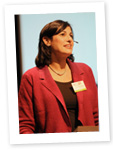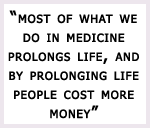Cost-effectiveness of HIV treatment - an interview with Prof. Walensky
 Could you please explain a little about your background and your work to date?
Could you please explain a little about your background and your work to date?
I started my work as a resident at John Hopkins Hospital in Baltimore, MA. Many of our patients during that time were injecting drug users (IDU) , and we saw a lot of AIDS-related death in the IDU population at that time. After my residency I came up to Massachusetts General Hospital in Boston for my clinical infectious disease fellowship. I spent my early time here doing research on increasing HIV screening; I worked with the Massachusetts Department of Health to test for HIV in Urgent Care Centers, and my first grant was dedicated to identifying the best strategies for HIV screening in an emergency department. Over time, focus turned to the global HIV epidemic and I became interested both in routine HIV screening and cost-effectiveness internationally.
Your latest paper in New England Journal of Medicine focuses on cost- effectiveness. Why is cost-effectiveness an important subject for HIV?
There are clearly not enough resources to do everything we’d like to for patients with HIV around the world. It is therefore critical that we think about efficient ways to spend  money. Our work examines the most cost-effective ways to allocate our resources. That is using cost-effectiveness as a tool to buy the best healthcare possible. One of the things that I found frustrating early in the epidemic were the “battles” between those who believed more strongly in prevention compared to those who believed more strongly in treatment. I think the amazing thing now is that we all together realize that allocating resources to treatment means that you are also going to get prevention benefits.
money. Our work examines the most cost-effective ways to allocate our resources. That is using cost-effectiveness as a tool to buy the best healthcare possible. One of the things that I found frustrating early in the epidemic were the “battles” between those who believed more strongly in prevention compared to those who believed more strongly in treatment. I think the amazing thing now is that we all together realize that allocating resources to treatment means that you are also going to get prevention benefits.
It is important to realize that saving lives costs money. Many people are hoping to see in our analyses that we are “saving” money by preventing infections. However, it is very difficult to show money is saved. Most of what we do in medicine prolongs life, and by prolonging life people cost more money. Certainly in HIV when people live longer they require ART for longer. For the patient this is a good thing, but it costs money. In our recent paper, we were able to demonstrate a cost saving, at least over a five-year period, in South Africa. This is of course very exciting; not only is it good for the patients, but it is also economically efficient; really in a win-win situation!
The focus of this paper has been on resource-limited settings. Is there any application for your research in resource-rich settings?
I think in most cases, or at least in the USA, we are applying it. Importantly, I would like to emphasize a point I also stressed in my talk at the NCHIV conference, and that is testing. The concept of test and treat means that you have to deploy a lot of resources to test people so that they will be identified and present to care early. How much those resources are going to cost in order to get the people at a mean CD4-count high enough to call your intervention test and treat, we do not know. During my presentation I discussed that the HPTN 052 trial specifically enrolled patients with a very high mean CD4 count of 449 cells/mm3. At this mean CD4 at ART initiation, our study demonstrated that treatment and prevention in South Africa would be cost-saving over a 5-year period of time and be very cost-effective over a lifetime. However the mean CD4-count at which treatment is started in South Africa right now is around 150 cells/mm3. I think it would require many resources (money, effort, political will) to increase the CD4-count at presentation from 150 cells/mm3 to 449 cells/mm3. This is also true in resource-rich settings where we still have much work to do in terms identifying people early enough.
You also work as a practicing physician. Does your work in HIV intervention relate to caring for your own patients?
When I see patients in a hospital or patient service, I find several things astounding: one is people are still presenting incredibly late to care. There are still people being diagnosed with HIV by having an opportunistic infection, and I see them almost every time during my clinical service. In addition to the wonderful fulfilment I get out of seeing patients, I also enjoy clinical time because it helps me to identify my next research question; what is it that patients are struggling with, how could my research help to make their lives better?
You’ve been a member of Cost-effectiveness of Preventing AIDS Complications (CEPAC) since 1998, what changes have you seen over the years in the focus of cost-effectiveness strategies?
Our research in the CEPAC group utilizes a mathematical simulation model. When I joined the team in 1998, we were just inserting viral loads into the model – this was the newest scientific discovery. In working with CEPAC, we believe our responsibility is to correctly account for all that which is scientifically feasible in HIV care. Right now we are working on a Cure analysis. That would not have been anything we would think about in 1998 – before HAART – when CD4-counts could only go down. So, we have incorporated an immense amount of material in the models, such as viral load, genotype, and, more recently HIV transmission.
» Watch the webcast of Prof. Walensky's presentation
» Download the NCHIV presentation of Prof. Walensky
